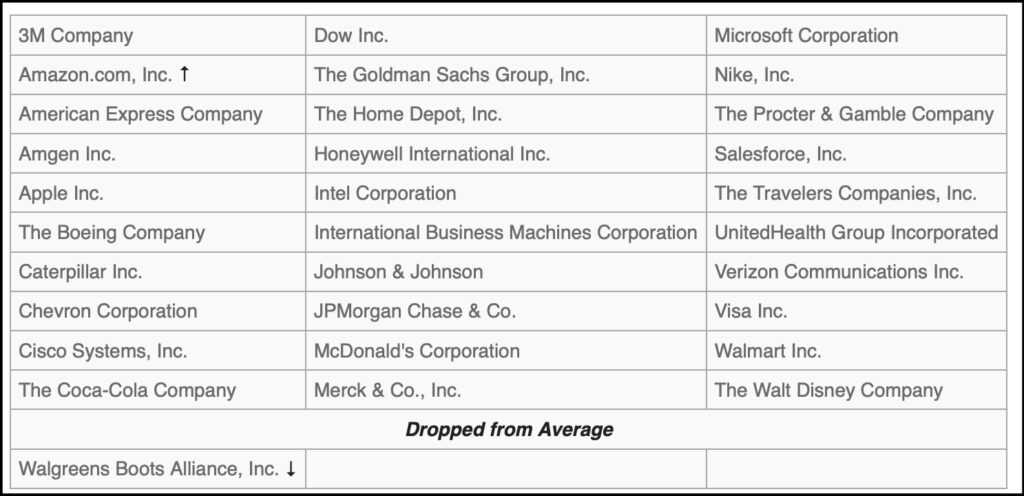
The addition of Amazon to the Dow with Walgreen’s unceremonious deletion, and the Dow’s current composition tells it like it is. Yes, Walgreen’s was a retailer, and Amazon is a retailer, so the Dow’s “Consumer Goods” sector weighting was maintained.
But not really. Of Amazon’s $25 billion of operating income for 2023, nearly $19 billion, or about 80%, came from Amazon Web Services or AWS and the balance, about $7 billion or ~20%, came from retailing. The old 80/20 rule is writ large at Amazon.
The Dow Jones Industrial Average Today

In reality then, Amazon is another technology company among the Dow’s ranks. If the Dow Jones index is a mirror of the U.S. economy at large, then yes, the removal of a retailer, even if appearances were preserved with the addition of a retailer in sheep’s clothing, the success and growth of the U.S. economy rests on technology.
To wit, even if a Dow component is not a technology company per se, i.e. Salesforce, IBM, Microsoft, its lifeblood is technology, re, Visa, Boeing, Disney.
Looking at the U.S. economy through the lens of the Dow shows just how much our economy has changed. Here’s the Dow the year I graduated from college, 1982.
The Dow Jones Industrial Average In 1982

Now that’s an industrial economy. You can almost feel the testosterone.
That many of the companies listed above don’t exist is also telling about the economy. American Can, Woolworths, International Harvester, Standard Oil, General Foods, Inco, Westinghouse, Sears are all gone. Eastman Kodak is a penny stock. They don’t exist, because their markets shrank, disappeared or went overseas.
When the precursor to the modern index was created by Charles Dow on July 3 in 1884, most of them were rail companies. One was a steamship company. These were not only the backbone of the country, but they propelled the American economy into today’s composition.
It’s telling then that the final company on the original list of 11 was The Western Union Telegraph Company, the original digital communications company that would drive, then overtake the U.S. economy. The seed for the development of our economy was planted long ago.
There’s something else looking at the Dow over the years can tell us: how fast the economy is changing. During the first 24 years of this century, the 21st, there have been 16 changes to Dow components. During the last 24 years of the 20th century, there were just eight. Changes to The American economy are happening twice as fast.
In the first years of the this century once unassailable Exxon Mobile left the Dow in 2020. General Electric, the embodiment of American industrial might left in 2018. Hewlett-Packard, the first Silicon Valley giant departed in 2013.
In the last years of the 20th century, Sears, which redefined retailing, left. When Bethlehem Steel fell in 1997, it signaled a sea change, and the inevitability of things to come was telegraphed when Microsoft joined the Dow two years later .
It is called The Dow Jones Industrial Average. But perhaps it should simply be called the Dow Jones Average, because the economy it chronicled no longer exists.
This article was first published on Nasdaq.com. To see this and other articles on Nasdaq by David Evanson, click here.
Sources:
Amazon segment income, p 68

